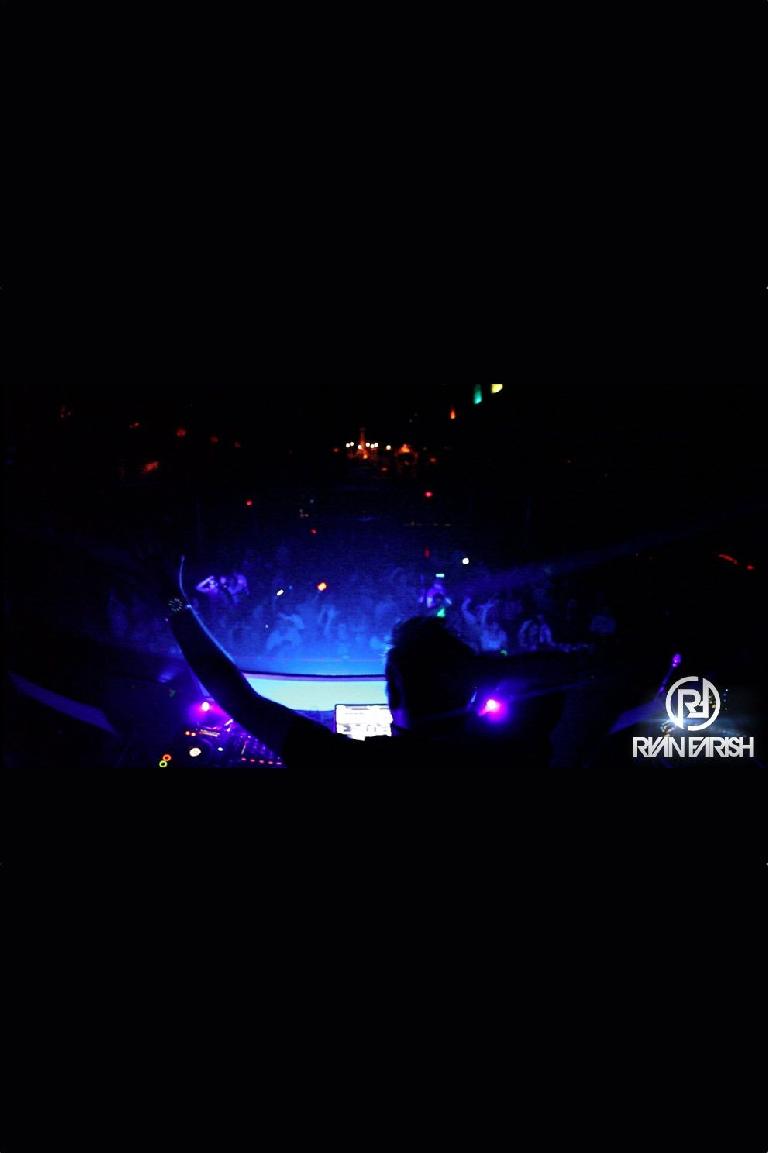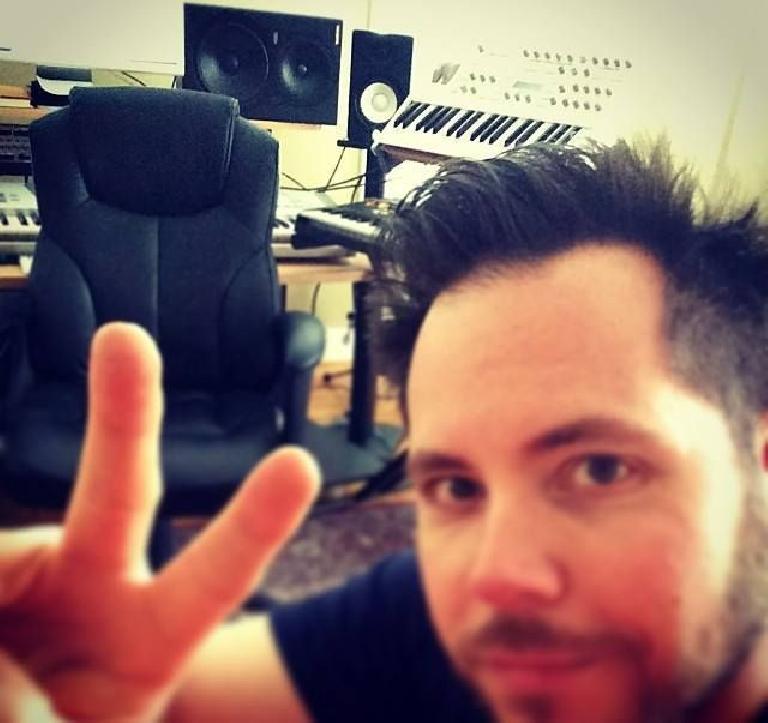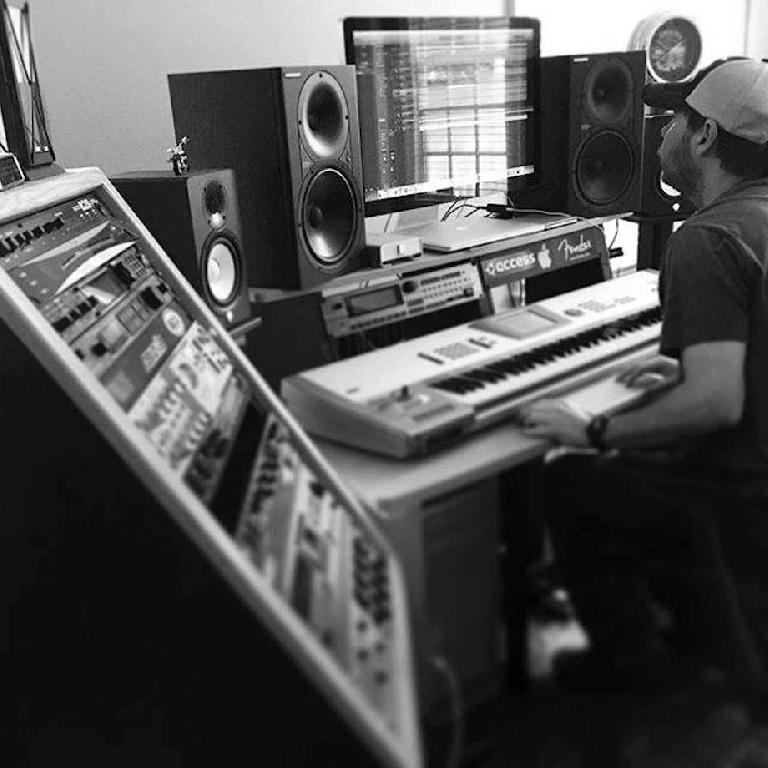Interview: Ryan Farish Talks Chillout Music Production Tips & Guiding Forces Behind Spectrum
Rounik Sethi on Sep 09, 2015 in Interviews | 0 comments
Ryan Farish is an artist, DJ, producer and co-writer of a Grammy nominated recording. With over 60 million views from user generated videos on YouTube and 32 million annual streams on Pandora and Spotify, it's no surprise that Ryan’s latest album, Spectrum, charted at #5 on the Billboard charts! Suffice to say Ryan Farish’s signature musical style continues to move a lot of people.
We caught up with the deep, charming and funny, Ryan over Skype to chat about the new album, his production techniques, the gear he uses, and his creative process. Also of interest are Ryan’s views on extending the life of music technology, how trance and chillout can be seen as essentially love songs, and the importance of making music for music’s sake.
Ask: I was just listening to Spectrum before the interview, which is a deep piece of work! I was completely immersed in “Raindrops on my window” and I want to mention again, this is a long album indeed. Was that intentional?
Ryan: Thanks! I didn’t start out with the idea of creating an album with 20 songs. As I began the album it just became a process and an enjoyable place for me. I remember when I had 10 or 11 songs and I was about ready to say this is an album. But I just didn’t want to stop. I didn’t want to leave that place that I was in musically.
I felt like the music was really giving me so much and making me feel so good. I just didn’t want to stop the album. I made a decision to really let this thing be what it’s going to be and I’ll let the music stop when it tells me to stop. When I got to track 20 it felt complete and time to close the door and move on to the next thing.
Ask: How long were you making the album for?
Ryan: At least a year and a half. I had been doing a few singles. In fact, the last release prior to Spectrum was a trance single called "Distance" featuring Coury Palermo. It would’ve probably made good sense to follow that single up with more trance, but I wanted to be in a place where I was making music for music’s sake. And when "Distance" came out I was two or three songs into Spectrum.
Ask: There are still trance-like elements that permeate throughout Spectrum. Perhaps sometimes not as obvious as on an out and out trance record?
Ryan: Absolutely. For the most part to me, trance music and chillout music can be love songs. Not just lyrically but the feeling of the music which are all about builds and releases and creating a place for the listener to really escape to. The big difference for me between trance and chillout is the BPM. A lot of times you can take the same chord progressions of a beautiful ballad, when you put in the right beat and raise the BPM and add certain effects, it’s the same song but it can wear two different outfits.
I’ve always been drawn to a lot of the plucks, arpeggios, and beautiful sounds in dance music, and try to incorporate those electronic sounds in what I do. But, when I approached Spectrum I wanted to make those builds and releases happen musically. You can create that same kind of build and release and you can do it in a subtle way with sophistication. I feel right now there’s a lot of electronic music out there in the world and a lot of it follows very similar formulas. I wanted to offer something that would be familiar in the feelings and the sounds, but it would have an approach and direction that would set it apart.
I’ve always believed when you create music you should try and be original in your sound, but also think about, and consider, what you can contribute to the whole universe of music. What is it you can do that can maybe give to music and inspire new directions and new flavors.
Ask: I’m really interested by the idea of some trance and chillout being like love songs. When listening to Spectrum I feel there is a sense of love within the album. Not necessarily a romantic love, but perhaps a love for something greater, or a love of nature? Is that fair to say?
Ryan: Yes. For me and many others music has always been a thing we can escape to and allows us to step into a place that we’re not. Music can transport us. I know this sounds very cliché. Often times I think that we can take an empty room that has no life… as soon as you start playing music the room has life. So music really is an intangible thing, but there really is life in it.
When I’m creating I try to really tap into life. Music is communication whether it has lyrics or not, it’s a very powerful form of communication. I try to have something worth saying in the music. To me something that’s worth say is something that can make someone feel love, hope and can feel almost like the sun is shining. That’s what I seek to communicate with my music.
I don’t sit there and try really hard to do that. That’s just what comes through when I sit there and makes me feel something and feel good.
Ask: Well it really comes across in the album. Before the interview I was listening to a "Sky Full of Stars" which is incredible. I think it’s possibly my favorite on the album…
Ryan: Thank you. I think it’s one of my favorites too. It’s definitely one of the ones I spent the most time on. That song started and I remember going, “wow.” It’s got a different rhythm than anything I’d done before.
Watch "A Sky Full of Stars" by Ryan Farish:
I remember I’d stumbled across a documentary on the making of Pink Floyd’s Dark Side of the Moon. David Gilmour was talking about being in the studio and they were firing up all these different synths and instruments. I really connected with that. I felt I wanted to do something ethereal, but not. Almost a sleepy day feel. Completely Chill Out!
Ask: And it is completely chilled, complete in its ambience, and yet uplifting too. I’d love to hear about the software and hardware you used on the album. There’s beautiful sparkly elements, delicate pianos, glittering guitars, and sublime synths that seamlessly blend into different sounds…
Ryan: With this album I challenged myself and wanted to raise the bar with the quality of the mix and production. I spent much longer than my normally allocated time to work on a tone, or the mix process.
In terms of gear I’m a firm believer in getting the maximum out of the equipment I have. I have friends who must have the very latest of whatever they use and they spend a lot of time acclimating and learning the new equipment. I use Logic Pro X on a Macbook Pro with 16 GB of ram. This is my first new Mac in almost 8 years!!
In terms of hardware, I’m mixing on a pair of Mackie HR824 monitors. I also use a set of Yamaha HS-50s. In terms of guitar amps and effects a lot of it happens in the box. But I do use the M9 multi-effects from Line 6. I do a combination. Sometimes I record guitar with hardware and sometimes I use Native Instruments Guitar Rig. Other times I’ll actually sample my guitar from the Vox AC30 and I’ll make things a bit tighter, especially when using multiple delays.
I remember sampling my palm muted guitar. I brought that into Logic and then created a sampler instrument out of that. Now that’s one of my sounds and I can grab that and keep moving. It’s really important to me that in the creative process I get ideas down quickly and don’t get hung up having to work out the tech stuff. It’s like racing to capture the idea in my head. The longer you spend on something, it’s just natural the magic can go away.
Ask: Do you find that in order to keep your muse or inspiration channel open that you’re looking to match the sound and tone, or the melody and rhythm?
Ryan: That’s a great question. In fact, on days I don’t have many ideas coming through I spend the time creating sounds and tones for myself. For instance, one of the sounds that’s on 70–80% of Spectrum is a Rhodes patch I made. That’s an example of a sound I spent hours making and there’s lots of channel strips from that. Then the day I have the inspiration it’s almost in concert with the idea I’m having and I’m remembering the tone and sound I made. I can grab that sound and I’m ready to go with it. So, I’m not having to do sound design and producing and writing at the same time.
Ask: What was your process of recording and mixing Spectrum?
Ryan: Years ago, the recording and mixing process blurred together somewhat and I still do both at the same time, but with Spectrum, sound design was one mode. Recording and inspiration was another mode. And mixing was its own thing. I’d go back later after the fact to mix tracks and spend days doing so.
Ask: Do you find that helped the tracks become tighter, more cohesive?
Ryan: Definitely. As I made a conscious decision that I’m not going to mix while I’m producing, it allowed me that freedom to think, “this sound isn’t 100% how I’d like it, but I’ll come back later and fix it.” I wasn’t focusing on each sound and getting too deep when recording. You can almost derail yourself doing that. With all the VSTs, it’s easy to get lost in a whole world of tweaking!
Ask: So this method provided you a form of sonic/composing liberation?
Ryan: For example, "A Sky Full of Stars". I got excited when you said it was your favorite because I spent longer mixing that than anything I’ve done before. It was a pursuit of simplicity. That was another approach to Spectrum. I really simplified things as much as possible. When you’ve got a track like that with a few elements, it allows you to go in and polish each element and create a lane for each sound so that it’s as pronounced as it can be and clear as it can be.
Ask: Back to software. What were your go-to plug-ins?
Ryan: For Spectrum I used a lot of plug-ins that were not in Logic Pro X. Pre-Spectrum I used a lot of plug-ins built into Logic. But, Spectrum I wanted to use a lot of new plug-ins I’d never used before.
I used Native Instruments’ Passive EQ. It’s an emulation of the Manley Massive Passive. It’s a beautiful plug-in. I used a lot of plug-ins from Waves like the SSL Master Buss Compressor, SSL E-Channel got used on just about everything. I used several plug-ins from Brainworx like the bx_digital V2 EQ and bx_refinement. It’s doing a few different things for you and allows you to get on with the creative process. I also used the SPL Transient Designer on a lot of drums and basslines. The Passeq is a wonderful EQ which is like a version of the Pultec boost and cut but does it across more frequency bands. I also used the Waves Audio CLA-2A and 3A compressors on a lot of tracks.
As for instruments, I used Spire a lot as well as Sylenth 1, Massive, and Nexus. For drums I use VPS Phalanx and VPS Metrum which is a beautiful bass drum designer that allows you to create a great kick by sculpting the different components like the sub, the click to make a well rounded, well-tuned kick. So it totally works with the bassline.
As well as Guitar Rig I use the NI RC-48 which is a great reverb. I made a preset on that when I first got it which I committed to which I used a lot.
Back in 2007 to 2008 I wrote songs with a friend for other people. I was quite new to being in a writing/production team. What I learned early on was what saved the day was having our templates and presets very organised, so when I needed a particular sound I’d know exactly where to go and get it. We weren’t held up trying to find a particular sound or preset.
I don’t claim to be well organised by the way. Someone else might look at my session in Logic and think, “What? Where is XYZ?” But, I know where everything is!
Ask: Are you planning on touring Spectrum live?
Ryan: That’s a great question. I’d love to. The whole performing thing is so separate from the studio. All my songs are made from beginning to end on my own time in the studio. I’ve done shows and love to tour but the challenge is the business behind the whole live and DJ thing going on. I recall a tweet by Matt Zo sent recently. The gist of what he said was: sometimes the venues and promoters don’t want your fans because fans don’t buy anything. An album like Spectrum wouldn’t fit into your normal live scene.

Ask: What kind of scene do you feel Spectrum would fit into best?
Ryan: More a feature-room kind of thing versus a club, but I don’t have plans to do a tour for Spectrum. Hopefully in the future my time will be spent more focused on that so I can connect with my fans that have been with me since the beginning. I don’t have this enormous fan base, but the ones I do have are amazing. They’ve allowed me to do my own thing and make music that doesn’t always fit with the mainstream. It’s music that’s not engineered for the mainstream that way, it’s music that’s made for music’s sake and for the experience.
If I could do a world tour that would be a dream come true. I’m a perfectionist and I’d want to do it right. With an album like Spectrum I’d want to have a great sound system and proper presentation of visuals. I’d need to be a good steward of the music if that makes sense.
Ask: What tips would you give to up and coming producers and musicians on their musical journey’s?
Ryan: One thing is there’s no substitute for hard work. When you’re starting off you don’t want to focus on the big hill you’re going to climb, but it is there and you’ll have to climb it with hard work. You need the desire and passion to self-educate and dive in and learn everything you can about making music.
Secondly, try to be original and contribute something with the music you make. Don’t just do it because you want recognition for it.
Also, there’s tons of great videos online where you can learn Logic or any DAW. Self-educating is important! The resources, videos and article tutorials you have at Ask.Audio are gold. I recall an instrumentalist that was recording with me some years ago who’d gone to one of the major bricks and mortar music schools. He told me he’d spent $40-50,000 in the school and in the two hours with me he’d learned more watching me than he felt he’d learned in all those years at school.
Him sitting there with me in the studio is really no different than when you’re watching David Earl teaching Logic in your video courses. It’s almost one-on-one. The guy in the studio with me was able to ask me a question and we’d go back and do it again. It’s really no different with videos where you can just rewind it and see and hear it. You guys have very affordable videos and it’s just incredible.
Ask: Thanks Ryan. Wish you the best with Spectrum and the very best for the future.
Links:
Ryan Farish Official Website
Ryan Farish on SoundCloud
Ryan Farish on Facebook
Buy Spectrum:
iTunes: http://smarturl.it/ryanfarish-spectrum
Google Play: http://bit.ly/1TFJ3Xi
Amazon: http://amzn.to/1Iq0nLA
Beatport: http://btprt.dj/1GWLIFz
Bandcamp: http://bit.ly/1dproSp





 © 2024 Ask.Audio
A NonLinear Educating Company
© 2024 Ask.Audio
A NonLinear Educating Company
Discussion
Want to join the discussion?
Create an account or login to get started!